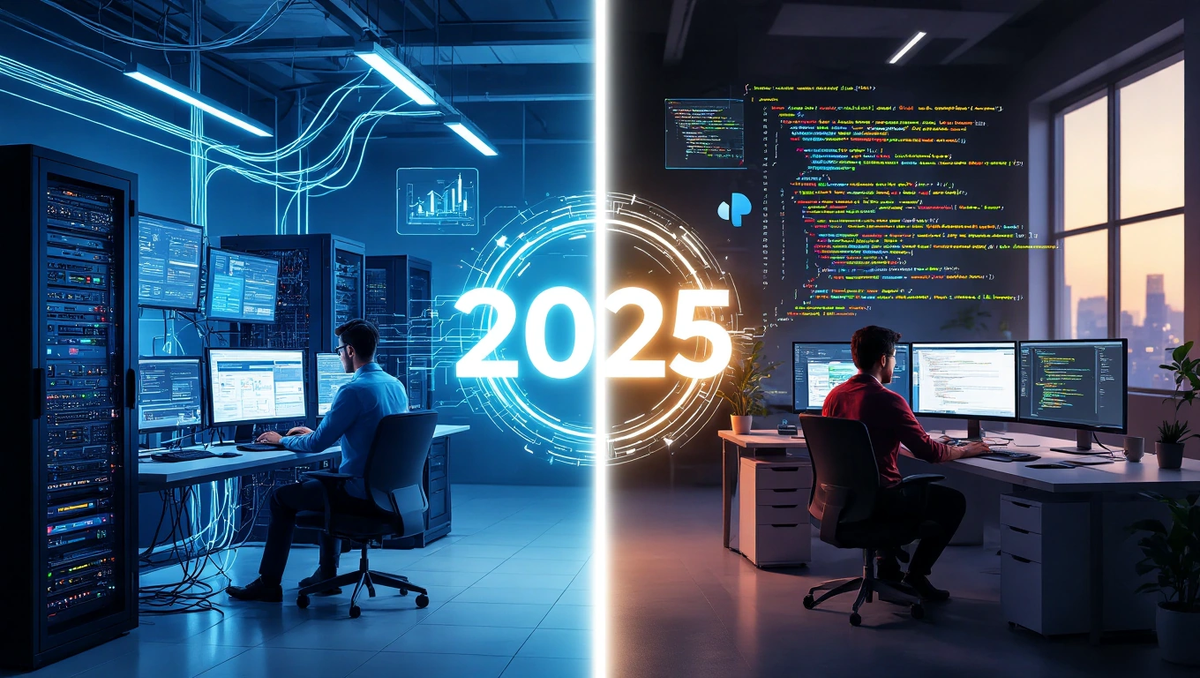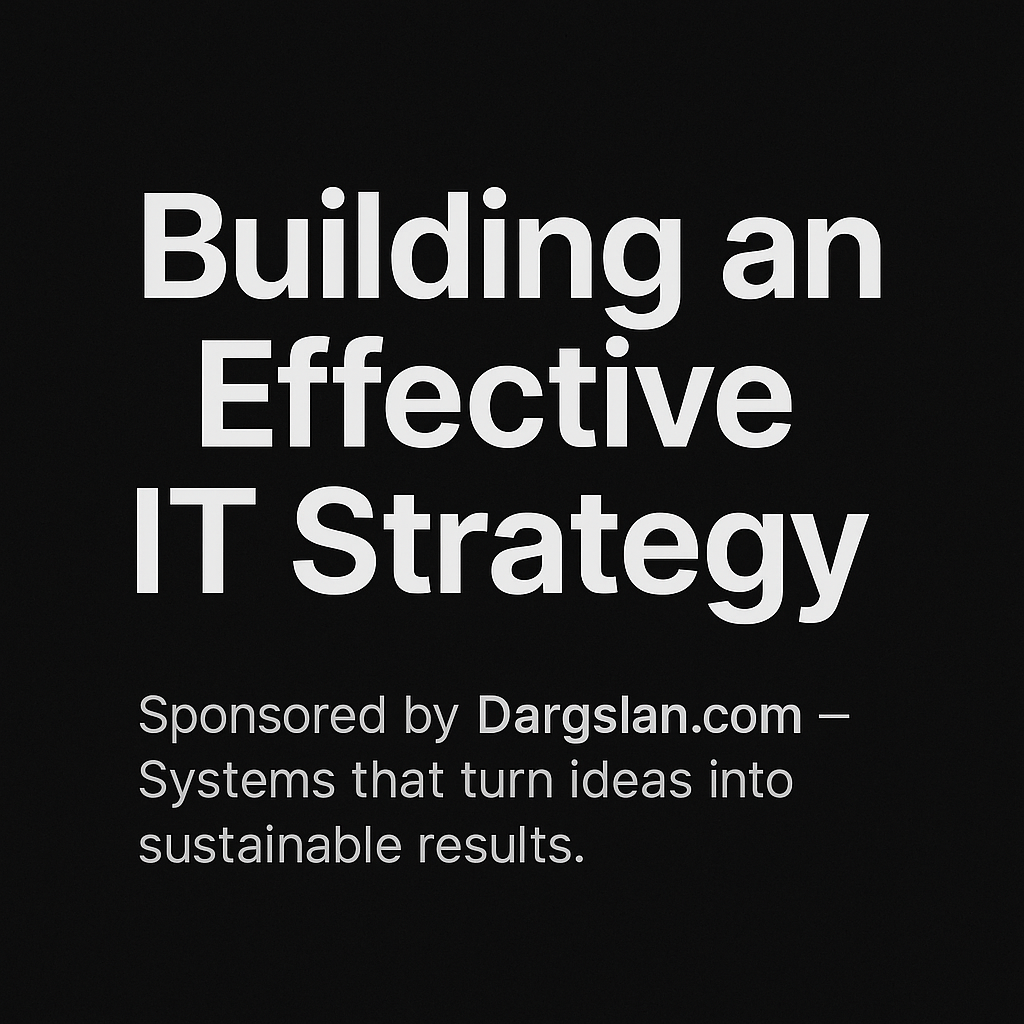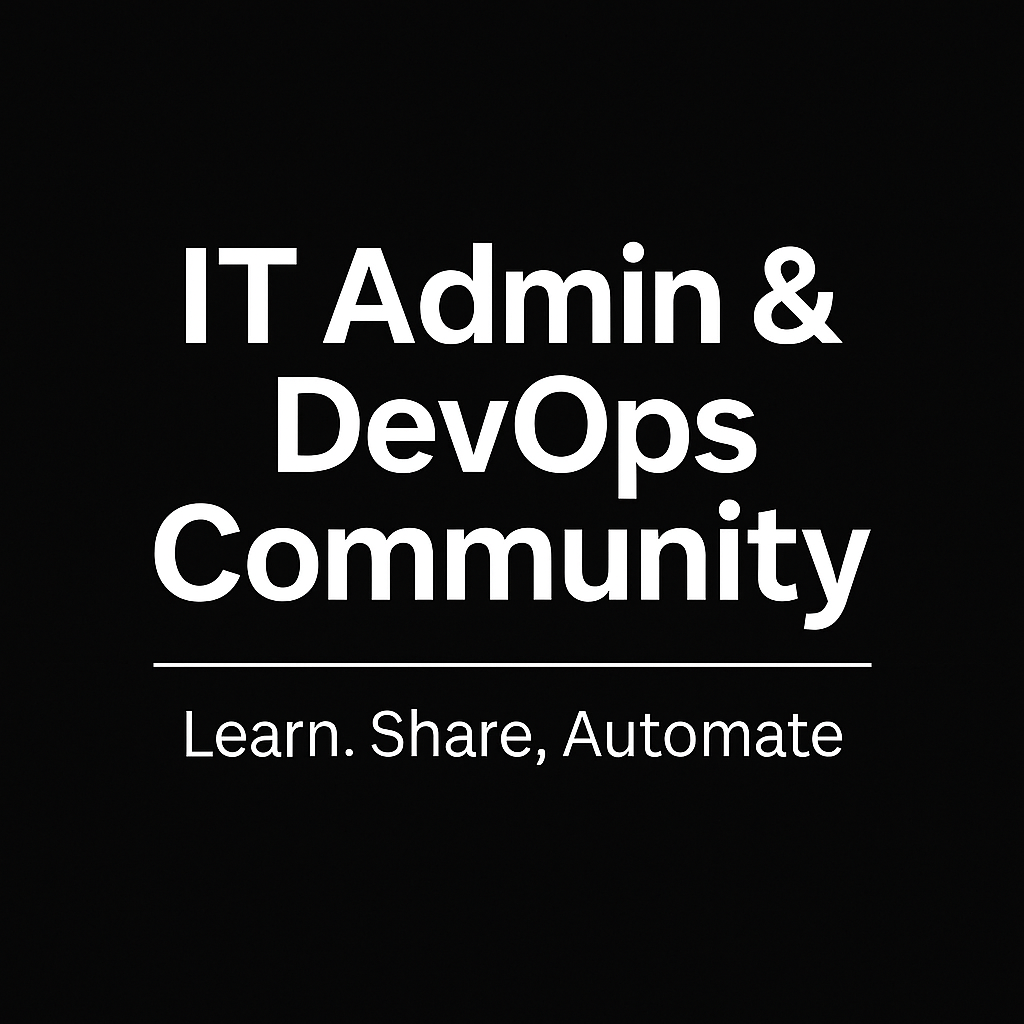IT Administrator vs Developer in 2025: Roles, Skills, and Future Outlook
In 2025, the line between IT Administrators and Developers is thinner than ever. This in-depth comparison explores their responsibilities, required skills, tools, and how both roles are transforming through DevOps, cloud computing, and automation.

How IT Admins and Developers collaborate, differ, and evolve in the era of cloud, automation, and AI.
Introduction
In modern IT organisations, the roles of an IT Administrator (often shortened to “IT Admin”, “SysAdmin”, “Systems/Network Admin”) and a Developer (software developer, application developer) are both critical — yet distinct. As we enter 2025, the rapid evolution of cloud, automation, DevOps, AI / ML, infrastructure-as-code and hybrid environments means these two roles are shifting, overlapping and evolving. This article will compare the two roles in depth: what they do, what skills they require, how their career paths differ, how they must collaborate, what challenges they face, and how the landscape in 2025 looks. A comprehensive table summarises the key differences and overlaps. If you are evaluating which path (or combination) to pursue – or just want clarity on “who does what” in your team – this article is for you.
For deeper technical resources, see dargslan.com.
Defining the Roles
IT Administrator
An IT Administrator is typically responsible for the stable operation, maintenance, performance, security and availability of an organisation’s IT infrastructure: servers, networks, storage, cloud services, access controls, backups, disaster recovery, monitoring. In 2025, this often includes hybrid cloud (on-premises + public cloud), containers, infrastructure-as-code, software-defined networking and strong focus on automation and security.
According to a recent article: “[IT Admin] roles are, by nature, more stable and reliable. They are all about keeping things running smoothly.” Atera
Developer
A Developer is someone who designs, writes, tests, maintains and enhances software applications, services, APIs, web/mobile front ends, back-end logic and database interactions. They transform business requirements into working code, build new features, fix bugs, and often operate in agile teams. In 2025, developers also increasingly engage with cloud services, serverless architectures, microservices, data pipelines, AI/ML integration, and DevSecOps (security built into development).
One article summarises: “Developers write, test, and maintain the code that makes everything … run smoothly.” software-league.com
Day-to-Day Responsibilities
IT Administrator
- Provisioning, configuring and maintaining servers (physical, virtual, cloud)
- Managing network infrastructure: switches, routers, firewalls, VPNs, VLANs
- Ensuring system security: patching OS/software, hardening, intrusion detection
- Monitoring system performance, logs, alerting, capacity planning
- Backup and disaster recovery planning & testing
- User account management, permissions, identity & access management
- Automation of repetitive tasks (via scripts, tools like Ansible, Puppet, CI/CD for infra)
- Cloud service management: e.g., AWS, Azure, Google Cloud — spinning up resources, securing them
- Incident response: troubleshooting outages, hardware failures, network issues
- Documentation of configurations, standard operating procedures, runbooks
- Collaborating with security teams, compliance teams (especially in regulated environments)
(Reflecting modern practice: “SysAdmins focus on the infrastructure and ensuring systems run smoothly.”) software-league.com
Developer
- Analysing business requirements and translating into software design
- Writing code in languages appropriate (e.g., Python, JavaScript/TypeScript, Java, C#, Go)
- Designing and implementing APIs, microservices, back-end logic, front-end UI
- Unit testing, integration testing, code reviews, debugging
- Working with version control (e.g., Git), CI/CD pipelines, deployment flows
- Collaborating with DevOps/infra teams to deploy and operate code in production
- Refactoring code, improving performance, reducing technical debt
- Integrating with third-party services/APIs, databases, cloud services
- Applying security best practices in development – e.g., OWASP, input validation, authentication/authorization
- Staying current with frameworks, libraries, platform changes (e.g., web frameworks, containerisation, serverless)
As one blog says, “A developer, also known as a programmer, is the mastermind behind the code …” software-league.com
Skill Set Comparison
Here is a detailed comparison of what skills are required or beneficial for each role.
| Skill Area | IT Administrator | Developer |
|---|---|---|
| Core technical foundation | Operating systems (Linux, Windows, Unix), virtualisation, networking, storage, cloud infrastructure, system security | Programming languages, frameworks, data structures & algorithms, software architecture, APIs, databases |
| Cloud & infrastructure | Provisioning, management of cloud VMs/services, hybrid infra, infrastructure-as-code (Terraform, ARM, CloudFormation), monitoring & logging | Leveraging cloud services (functions, managed DBs, messaging), writing cloud-native apps, understanding deployment environments |
| Automation & scripting | Shell scripts, PowerShell, configuration management (Ansible, Puppet, Chef), container orchestration (Kubernetes) | Writing code to automate workflows, build pipelines (CI/CD), tests, create developer tools/scripts |
| Networking & security | TCP/IP, DNS, firewalls, VPNs, VLANs, identity & access management, patch management, incident response | Secure coding, authentication/authorization, OWASP/top-10, integrating with security tools/APIs |
| Collaboration & process | Working with operations, support teams, documenting systems, SLA adherence, uptime/resilience | Agile methodologies, pair programming, code reviews, collaborating with product owners & QA, delivering features |
| Monitoring & performance | Infrastructure metrics, logs, capacity planning, SRE/DevOps overlap | Application performance (APM), profiling, scalable architecture design |
| Business & user focus | Ensuring system reliability, uptime, user-support, service delivery | Translating business requirements into software, UX/UI awareness, user feedback |
| Continuous learning | New infra tech, cloud platforms, security trends | New languages/frameworks, frameworks, tools, architecture patterns |
| Typical tools | VMware, Hyper-V, AWS/Azure/GCP console, Ansible, Nagios/Prometheus, Terraform, network devices | IDEs (VSCode, IntelliJ), Git, Jenkins/GitHub Actions/GitLab CI, Docker, React/Angular/Node, Python, Java |
Whilst there is overlap (especially via DevOps), these are different emphasis areas.
Career Path & Growth
IT Administrator
- Entry level: Junior system administrator, desktop support, network support
- Mid-level: System/Network Administrator, Cloud Infrastructure Engineer, DevOps Engineer (infra side)
- Senior: Senior Systems Engineer, Infrastructure Architect, Site Reliability Engineer (SRE), Cloud Architect, Head of IT Operations
In 2024/25 commentary: “Administrator roles are, by nature, more stable and reliable … you’ll be the go-to person for resolving issues … the job might also require being on call outside of regular work hours.” Atera - With automation and cloud infrastructures, many IT Admins evolve into “Infrastructure Engineer” or “DevOps Engineer” roles, gaining coding/scripting skills, bridging toward developers.
Developer
- Entry level: Junior Developer, Software Engineer I
- Mid-level: Software Engineer II, Full-Stack Developer, Backend/Frontend Specialist, DevOps/Platform Engineer
- Senior: Senior Software Engineer, Tech Lead, Software Architect, Dev Lead, Principal Engineer
- With growth, developers may move into Solution Architect, Engineering Manager roles, or specialise deeply in e.g., data, AI/ML, embedded systems.
As one resource summarises: “When it comes to the question of ‘Admin vs Developer’ … a developer uses code daily, whereas an admin tends to use ‘clicks, not code’.” Salesforce Ben
Collaboration and Overlap
In 2025, the boundary between IT Admin and Developer is increasingly blurred — particularly under DevOps, SRE, cloud-native and automation mindsets. Here’s how they intersect:
- Deployment pipelines: Developers build applications; IT Admin/Infra teams build, maintain and automate the infrastructure and CI/CD pipeline that delivers those applications to production.
- Infrastructure-as-Code: Admins increasingly write scripts/configs for infra; developers may contribute to or consume those configurations.
- Monitoring and reliability: Developers may instrument their code for observability; admins set up the monitoring tools and alerts.
- Security: Developers implement secure code; admins secure the infrastructure, networks and enforce policies.
- Incident response: When application issues occur, both roles may collaborate (developer debugging code + admin checking infra/network).
- Shared tools & responsibilities: Containers, Kubernetes, cloud services, scripting, APIs – both roles often touch similar technologies.
One article noted: “The line separating administrators of systems from website builders is getting harder to draw as technology develops … this change pushes web developers to learn skills like handling servers, cloud computing, and pipelines … system managers frequently need to be proficient in scripting and coding.” reviewnprep.com+1
Thus, while the core focuses differ, collaboration and skill-sharing are essential.
Key Differentiators
Here are some of the main distinctions between the roles in 2025:
- Focus: Admins → infrastructure, operations, stability; Developers → code, features, user-facing functionality.
- Tools: Admins → infra-tools, monitoring, network devices; Developers → codebases, IDEs, version control.
- Output metric: Admins → uptime, performance, system availability, incident response; Developers → working features, code quality, user value.
- Reactive vs proactive: Admins often handle reactive issues (outages, failures); developers work more proactively (new functionality, enhancements). But both are becoming proactive with automation and SRE.
- Coding emphasis: Developers code daily; Admins may script/automate, but not necessarily develop full applications.
- Career perception: Admin roles are often more stable and operational; developer roles often seen as more dynamic, creative but also more pressured. Atera
Challenges in 2025
For IT Administrators
- Keeping pace with cloud & hybrid environments: migrations, new services, cost controls.
- Automation & scripting expectation: admins must learn more coding, infrastructure-as-code.
- Security & compliance: data breaches, ransomware, regulatory demands (GDPR, etc).
- On-call and incident stress: availability uptime expectations remain high.
- Shortage of talent: as operations become more complex, demand for skilled admins rises.
- Balancing new tech with legacy systems: many organisations still run old systems whilst adopting cloud.
For Developers
- Rapidly changing frameworks/tools: need to continuously learn.
- Deployment/operations expectations: developers may be expected to know about DevOps and infrastructure.
- Security and compliance baked in: “shift-left” security means developers must build with security in mind.
- Better collaboration across teams: devs cannot work in isolation from operations and infra.
- Scalability and reliability demands: applications must work globally, at scale, often serverless or microservices.
- Technical debt and legacy code: older systems still need maintenance, not just new greenfield builds.
2025 Trends Impacting Both Roles
- Cloud-Native & Serverless: Both admins and developers must understand serverless computing, managed services, event-driven architectures.
- Infrastructure as Code (IaC): Admins use Terraform/ARM; developers may consume infrastructure templates or even write them.
- DevSecOps: Security is integrated into development and operations workflows; roles must collaborate more closely.
- Observability and SRE practices: Instead of traditional monitoring, both roles adopt observability, alerting based on SLIs/SLOs.
- AI/ML and Automation: Admins use AI for anomaly detection, predictive maintenance; developers build AI/ML-driven features or integrate with AI services.
- Hybrid/Edge computing: Infrastructure expands beyond central data centres; developers build for distributed environments; admins manage more complex topology.
- Remote/Distributed Work: Both roles support remote infrastructure and distributed teams; developers build remote-friendly apps; admins manage remote access, VPNs, collaboration tools.
- Low-Code/No-Code Platforms: Some administrative or developer tasks might shift into low‐code tools; roles adapt to higher‐level automation.
Which Role is “Better”?
It’s not about one being “better” than the other — it depends on your interests, skills, personality and career goals:
- If you enjoy stability, operational challenges, keeping systems running, infrastructure, networks and automation, an IT Admin path may suit you.
- If you enjoy creativity, writing software, building user-facing features, collaborating on product development, the Developer path may be more fulfilling.
From a career-advice article:
“If creativity, sharp deadlines, and design speak to you – start down the road towards programming and development. If collaboration, fire-fighting, and more diverse work tasks suit your personality more – it’s likely that administration is a better fit.” Atera
Also—many professionals find they can evolve from one to the other (e.g., admin → DevOps → developer, or developer → infrastructure architect) depending on continuing education and cross-skills.
Summary Table: IT Administrator vs Developer (2025)
| Category | IT Administrator | Developer |
|---|---|---|
| Primary goal | Maintain and ensure availability, performance and security of infrastructure and platform | Build and deliver software applications and services that meet business requirements |
| Key responsibilities | Server/network provisioning & maintenance, monitoring, backups, security, user access, infrastructure automation, cloud/edge management | Requirement analysis, design, coding, testing, deployment, code review, bug fixing, feature delivery |
| Typical technologies/tools | Linux/Windows servers, networking gear, firewalls, cloud infra (AWS/Azure/GCP), IaC tools (Terraform), monitoring/alerting (Prometheus, Nagios) | Programming languages (Python/JS/Java/C#), frameworks (React/Angular/Node/… ), version control (Git), CI/CD (Jenkins, GitHub Actions), APIs, databases |
| Core skills | Systems admin, networking, security, cloud infrastructure, automation, incident response | Software engineering, algorithms/data structures, frameworks/libraries, test automation, version control, deployment pipelines |
| Work style | Often reactive (resolving issues) + proactive (capacity planning, automation) | Mostly proactive (feature delivery) with some reactive (bug fixes, refactoring) |
| Collaboration | Works across teams: support, security, developers, operations | Works with product owners, QA, operations, stakeholders |
| Training focus | Networking certs (CCNA/CCNP), system admin certs, cloud certs (AWS Certified SysOps, Azure Administrator), scripting | Computer science fundamentals, software design, programming languages, modern frameworks, cloud services, DevOps practices |
| Career trajectory | Junior SysAdmin → Systems/Cloud Engineer → SRE/Infrastructure Architect → Head of Operations | Junior Developer → Software Engineer → Senior/Lead → Software Architect/Engineering Manager |
| Major trends affecting role | Cloud migration, automation, SRE, edge computing, security threats | Cloud-native apps, microservices, AI/ML, DevSecOps, low-code/no-code platforms |
| On-call/availability | High likelihood (night/weekend issues) | Less frequent but still possible (critical bugs, production incidents) |
| Creative vs operational | More operational, infrastructure-centric | More creative, feature-centric |
| Which personality fits? | Detail-oriented, calm under pressure, enjoy variety of tasks, good at troubleshooting | Innovation-driven, enjoy building things, comfortable with change, strong coding focus |
Advice for Aspiring Professionals
- Cross-skills matter: Even if you choose one path, gaining skills from the other will boost your value. For example, an admin who can script and understand code is more capable. A developer who understands infrastructure/operations can build more reliable applications.
- Certifications and learning: For admins: cloud certifications (AWS/Azure/GCP), security certs (CompTIA Security+, CISSP), networking certs. For developers: solid foundation in programming, modern frameworks, software architecture, DevOps pipelines.
- Choose based on interest: Ask yourself:
- Do I enjoy fixing issues, digging into logs, rebooting servers, network troubleshooting? Or do I prefer designing features, writing code, delivering value to users?
- Do I like infrastructure, networks, stability, or building and innovating?
- Understand DevOps/SRE culture: In 2025 many companies adopt “you build it, you run it” or SRE models — meaning developers may need to engage in operations, and admins may adopt more development practices.
- Stay current: The tech landscape changes quickly. Invest regular time in learning new tools/techniques.
- Focus on business value: Both roles benefit if you understand how your work contributes to business outcomes (uptime, performance, user satisfaction, feature adoption).
- Soft skills count: Communication, collaboration, documentation, problem-solving. For admins: scenario-based troubleshooting. For developers: design discussions, code reviews, working in teams.
- Consider long-term goal: If you aim for architect/lead roles, plan accordingly. For example, admins might move toward Cloud Architect or SRE Lead; developers toward Software Architect or Engineering Manager.
Final Thoughts
In 2025, neither the IT Administrator nor the Developer role can be considered “less than” the other. They are complementary and interdependent. The technology landscape demands that infrastructure be reliable, secure and automated — and that software be innovative, efficient and maintainable. Organisations succeed when these roles work together seamlessly.
If you are choosing your career path, consider where your strengths and interests lie, but also recognise the permeability between the roles. Many modern “DevOps” or “Cloud Engineer” positions combine aspects of both. Ultimately, what matters is delivering value: whether through stable operations or impactful software.
For deeper articles, tutorials and guides on IT Admin, Developers, DevOps, scripting, automation and more — visit dargslan.com.




